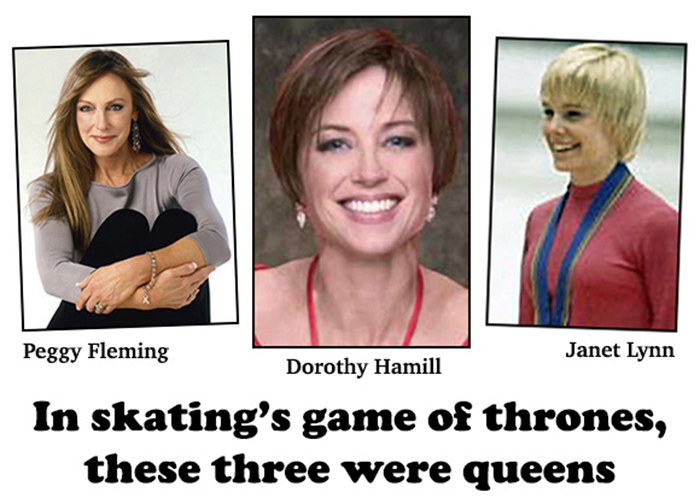
|
During my years in Akron, Ohio (1962-68), with the Beacon-Journal, I had no occasion to interview a figure skater. Yet two of the most famous skaters in the country had Akron connections — Hayes Alan Jenkins was born in the city, and two years before I moved there, Jenkins had married Olympic gold medalist Carol Heiss, and they lived in Akron for many years afterward.
Certainly someone at the newspaper must have talked to them, especially Ms. Heiss when, in 1961, she made a bid to become a movie star by playing Snow White in the dreadful “Snow White and the Three Stooges.” The film bombed, but Ms. Heiss was offered another film, anyway. Displaying the intelligence and good sense that has marked her life, she refused the offer and returned to Akron, and became the reigning queen of American figure skating.
As I recall, Akron, at the time, had no arena suitable for traveling ice shows, so there were no interviews offered with any professional skater for publicity purposes. That changed when I moved to Providence in 1969 and joined the staff or the Journal and the Evening Bulletin. Soon after I arrived, the city replaced its old ice rink that had been the home of the American Hockey League Providence Reds, and built the Providence Civic Center (later the Dunkin’ Donuts Arena). After that there were, I think, at least two ice shows every year in Rhode Island, all of them headlined by a well-known figure skater
.
However, my first interview with a skating star — who would succeed Carol Heiss as America’s ice queen — was scheduled in connection with an appearance at a very unlikely Rhode Island venue. |
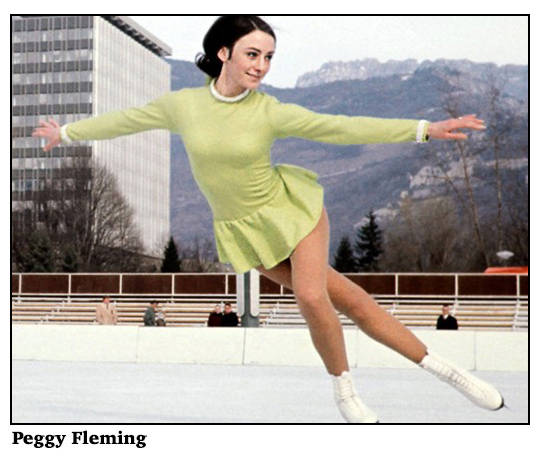 |
WHEN BURTON “Buster” Bonoff announced his line-up for the 1972 summer season at the Warwick (RI) Summer Theater, the usual names were included — Mitzi Gaynor, Sandler & Young, Sergio Franchi, Wayne Newton, Tom Jones, and, of course, Liberace. The summer’s final attraction, Peggy Fleming, seemed, at first glance, to be a joke.
An ice show at a theater-in-the-round? Surely, Bonoff couldn’t be serious. But he was dead serious, and also a bit nervous.
Fleming, the former Olympic figure skating champion, had toured during the winter of 1971-72 as star of the Ice Follies, playing in arenas that had hockey-sized ice rinks. How much skating could she do atop an elevated stage on a portable ice rink that measured just 35 by 30 feet?
We’d soon find out, as would audiences at nine other summer theaters on her tour.
BONOFF WASN'T going to wait until Fleming’s show, “A Concert on Ice,” arrived in Rhode Island. He flew to Cleveland several weeks earlier to watch Fleming perform under a tent at a place called Musicarnival. He wanted company, so he asked me to join him. It was a gamble. If Fleming’s show was a stinker, I’d say so in the Providence Journal, which, at the time, covered Rhode Island like a blanket.
However, the first thing the trip accomplished was too smooth the rocky relationship I had with Bonoff. I had a tendency to shoot from the hip, and my often immature efforts to be clever in interviews and reviews had rubbed Bonoff the wrong way for three years. But by the time our plane touched down at Cleveland’s Hopkins International Airport, Bonoff and I were . . . well, not buddies, but certainly cordial. And both of us were curious to see how well Ms. Fleming succeeded in something I'd subtitled, “The Incredible Shrinking Ice Show.”
To my surprise, and perhaps to his, Fleming's show was highly entertaining, partly because it was so different from the usual summer fare at tent theaters. (Even after a permanent facility opened in Warwick, people referred to it as “the tent.”)
FLEMING'S SKATING, even subdued, was the main attraction in “A Concert on Ice,” but the supporting acts included a European skating team, Cathy Steele and Willy Bietak; a comic skater, Eric Waite; pianist Walt Wagner; the singing Willis Sisters, and comedian Mike Nuen, who used a guitar as a prop.
After the show, Bonoff and I went to Ms. Fleming’s dressing room, where I could interview her after Bonoff asked a few questions about the show's logistics. She had submitted to interviews at every stop, and a glance at stories still available on-line indicates Ms. Fleming pleasantly surprised every journalist, who, like me, had imagined an almost too-elegant creature who likely was pampered throughout every waking hour. She was so graceful on the ice, that it was easy to picture her floating through life.
Instead she greeted us in Levis and a sweatshirt,, and was holding a long-neck bottle of Budweiser in her right hand. She urged us to sit, and, if I remember correctly, she plopped backward in an armless, spindle-back chair, looking very much like one of the guys who wanted to talk sports.
I don’t remember much of what she said, but for the most part the subject was the unique size and format of her show.
After winning Olympic gold in 1968, she waited awhile before getting into the ice show circuit, doing so after signing a contract with Bob Banner, best-known for his work in producing television shows. Not surprisingly, Banner first arranged two TV specials for the skater, “Here’s Peggy Fleming” (1968) and “Peggy Fleming at Madison Square Garden.”
When she agreed to join “Ice Follies,” she stipulated she’d do it for only 26 weeks a year, instead of the usual 44. She was the first skating star to make such a demand. She wouldn't be the last.
IT WAS BANNER who came up with the idea for “A Concert on Ice.” (While it seemed to work out well, I don't think she ever tried it again after 1972.)
Things went off perfectly in September when she opened in Warwick, though a website, bonoff.net includes a comment from Chris Brooks, who wrote, “And I too remember Peggy Fleming being there, the stage turned into an ice rink and poor Peggy almost flying into the orchestra pit when an audience member snuck out their camera and the flash caught her right in the eye.”
Another interviewer, Janet Bronschidle of the Tonawanda (NY) News, had interviewed Ms. Fleming earlier in the summer and came up with tidbits more interesting than anything my questions prompted.
“My hair is the hardest thing in skating,” Ms. Fleming told the reporter. “The humidity is unbelievable on the ice and it )my hair) goes absolutely straight. The only thing I can do is leave it set until just before I go on, and then use lots of hair pieces.”
She also admitted that being feminine was more important than being the best figure skater. Ms. Fleming claimed she never learned to do a triple jump because “No sport is worth looking muscle-bound for.”
FLEMING, who’ll turn 71 years old on July 27, 2019, has been married 50 years to Dr. Greg Jenkins, a former amateur skater, and, as far as I know, not related to Carol Heiss's husband, Hayes Jenkins.
In retirement, Ms. Fleming was a fequent television commentator for ice shows. She survived breast cancer in 1998, and she and her husband owned the Fleming Jenkins Vineyards and Winery in California until 2011. They have two sons and three grandchildren.
In 1972, Jenkins had a Porsche 911T, and occasionally raced it. Not to be outdone, the competitive Ms. Fleming got behind the wheel and did some racing herself. And I would have thought that a very un-Peggy Fleming thing to do — except I saw her chugging down a Budweiser, looking very much like a tomboy than the diaphanous creature she seemed to be on the ice, where her style was more important that her athleticism. |
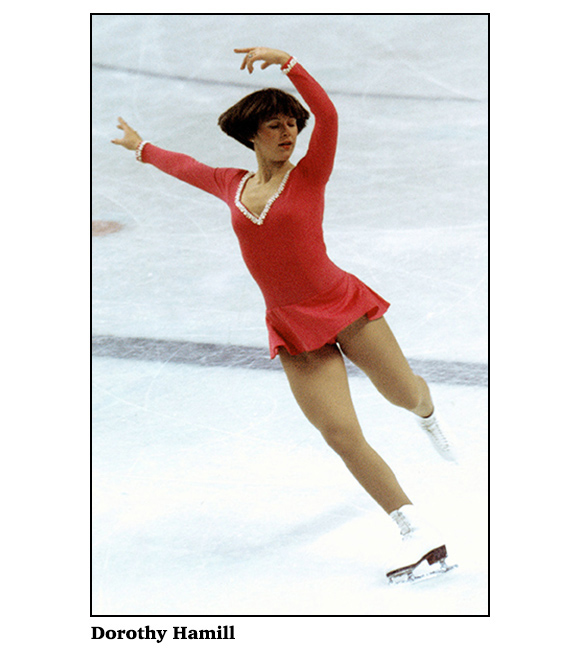 |
WHEN DOROTHY HAMILL won the Olympic gold medal in 1976 she was the last figure skater to do so without a triple jump. Like Peggy Fleming, Hamill achieved success through finesse and style, though I think most people felt Fleming was in a class by herself. She was sleek and slim; Hamill sometimes appeared bottom heavy.
Ah, but Hamill's lovely face had most of our attention. Hamill, who is near-sighted, provided a wonderful television moment for the way she squinted at the scoreboard to see the figures that resulted in her Olympic win. At that moment, she seemed very vulnerable, and incredibly cute. Understandably, she was proclaimed “America’s sweetheart,” and the style of her distinctive short hair became known as the “Dorothy Hamill wedge.”
I met her briefly in Providence while she was on tour with Ice Capades. The conversation didn’t amount to much — she seemed distracted, but I can’t remember the cause. I don’t think she had yet married Dean Paul Martin, but they were dating. What I recall most is she had the most beautiful face of any celebrity I ever interviewed. The list of glamor girls who were subjected to my questions face-to-face isn’t particularly long — it includes Raquel Welch, Ali MacGraw, Linda Evans, Lola Albright, Jayne Mansfield, Denise Nicholas and Mary Tyler Moore — but Hamill had them all beat. (My other favorites were singer-actress Carol Lawrence and Pat Woodall, one of the original daughters on “Petticoat Junction”).
HAMILL AND MARTIN got married in 1982, divorced in 1984. She then married Kenneth Forsythe in 1987, but was divorced eight years later. During that marriage she had a daughter, Alexandra. She married her third husband, John MacColl in 2009, when she was 53 years old. She has written two autobiographies, “On and Off the Ice” and “A Skating Life: My Story.”
Diagnosed with breast cancer in 2007, she has since been active in spreading the word about how to spot and treat the disease.
I had few celebrity crushes over the years, but Dorothy Hamill was my biggest. During the 20 minutes or so that I talked to her, she was soft-spoken, pleasant, but distracted, and in need of comforting — for something. I never went out of my way to read about her, perhaps afraid to find out she was actually a harridan. (Oh, I did once read that she was a spendthrift, which was threatening her marriage to Martin.)
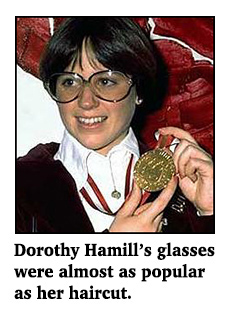 Peggy Fleming told an interviewer many years ago that she was well aware female skaters were judged, in part, by their appearance, and she worked hard to maintain hers. In the process, she became the model by which future skaters were judged. She was a beautiful woman — even with a beer bottle in her hand — and she had an amazing figure. Peggy Fleming told an interviewer many years ago that she was well aware female skaters were judged, in part, by their appearance, and she worked hard to maintain hers. In the process, she became the model by which future skaters were judged. She was a beautiful woman — even with a beer bottle in her hand — and she had an amazing figure.
Dorothy Hamill looked more like the girl next door, and while she may not have measured up to Fleming in some ways, she did have the head and hair that were the envy of women everywhere, and was even more lovable when, off the ice, she was seen in those oversized glasses of hers. In those glasses, she made me think of Supergirl. |
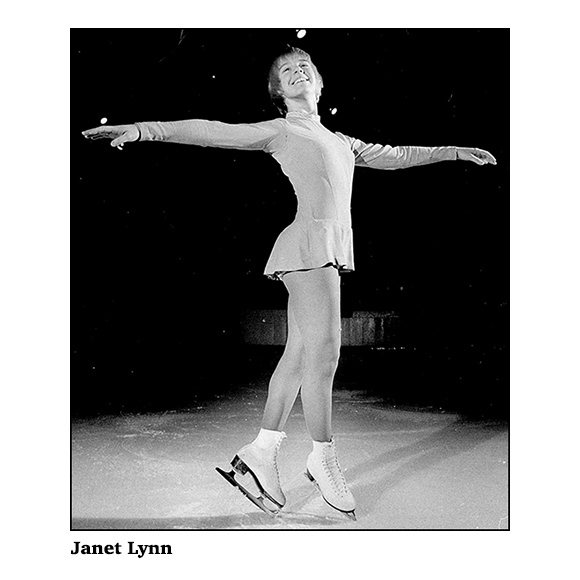 |
AND THEN there was Janet Lynn, who filled the gap between Peggy Fleming and Dorothy Hamill, and is recalled as one of the best skaters who never won a gold medal. Her full name was Janet Lynn Nowicki, and she was the United States figure skating champion from 1969 through 1973. After she turned pro with the Ice Follies — becoming the highest paid female athlete — she won a Dick Button-staged competition that designated her the World Professional Champion.
Janet Lynn was small — five-feet-two-inches — and had short blonde hair and a cute face that made her look a few years younger than she really was. When the Ice Follies came to Providence — in 1974, I think — she faced the local media in one of those free-for-all press conferences that can make even seasoned performers uncomfortable. Janet Lynn looked like the proverbial deer in the headlights.
Word was she had lost her enthusiasm for performing on ice, and her unhappiness led to over-eating, which resulted in a weight problem, though that wasn’t noticeable from where I sat. However, her uncertain answers gave the impression she was unhappy — or, putting it a slightly different way, she wasn’t happy. At that moment, she seemed an unlikely choice to headline an elaborate ice show, which I placed in the same category as a circus.
THE STORY I wrote about Janet Lynn after that press conference was unnecessarily cruel. I had reached the correct conclusions about her future as a professional skater, but didn’t know most of the reasons. I thought she was a sweet kid who simply was out of her depth, but there was more to it than that.
A friend of mine, Red McCreary, who was the sports director for the CBS affiliate in Providence, knew Ms. Lynn from Rockford, Illinois, and he expressed unhappiness over the way I had described her. She was a 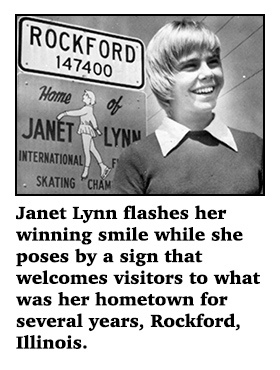 much better skater than I had given her credit for, he said, and was an extremely nice person who didn’t deserve to be written off as someone who didn't deserve to be the star of Ice Follies. But even McCreary admitted the young woman was troubled by her situation. much better skater than I had given her credit for, he said, and was an extremely nice person who didn’t deserve to be written off as someone who didn't deserve to be the star of Ice Follies. But even McCreary admitted the young woman was troubled by her situation.
Most of us were unaware of her allergy-related problems caused by working in cold, damp skating rinks, with few days off, for more than half the year. She left the show soon after her Providence appearance, completing just two years on her three-year contract, retiring in 1975. She got married about a month after she retired.
I owe Ms. Lynn an overdue apology. I didn’t understand how she must have felt about her life at the time until I recently found a 1981 article written by Jane Leavy of the Washington Post. At the time, Ms. Lynn had come out of retirement and was about to participate in another World Professional Skating Championship at Washington’s Capital Centre.
She told the reporter she expected to do badly, and was afraid she would “get back into the same problems I had before,” and would “fall back into that battling with ego and being mindless and being pushed around again.”
Actually, she did quite well in the event, though no individual honors were presented because, at the time, that particular competition was a team event. She and Ms. Hamill were members of the winning team.
Ms. Lynn continued to skate until 1983 when the event resumed individual competition and she again was named the Professional Figure Skating Champion. She retired again, this time for good, as Dorothy Hamill went on to win the event four years in a row.
ALSO INTERESTING in that 1981 Washington Post article was Janet Lynn telling the interviewer than in 1970, when she was the reigning U. S. Ladies Figure Skating Champion, she was unaware that four students had been killed at Kent State. She claimed that when she signed her contract with Ice Follies in 1975, she did not know how to write a check, and when she was married two years later, she did not know how to start a washing machine.
“In women’s figures skating,” she told Ms. Leavy, “in order to become a champion, you can’t think. You have to choose not to think. You have to listen to what everyone else says.”
I believe by the time she faced reporters in Providence, Ms. Lynn had decided to start thinking and listen to herself for a change.
She told Ms. Leavy the first thing she did when she quit Ice Follies was get a perm and let her hair return to its natural color, which she described as “mousey brown.”
She kept her hair its natural color until she returned to skating for three years in the early ‘80s. She was urged to dye it and be blond again. “I did it,” she told Ms. Leavy, “because it looks better, but I made the decision.”
AS FAR AS I can tell,
Janet Lynn has since kept her hair short and blonde. She remains married to Richard “Rick” Salomon — no, not the professional poker player; he married Pamela Anderson. Janet and her 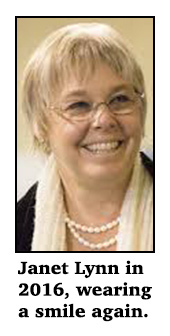 Rick Salomon have five children. She also returned to skating, this time as a judge, who has positive things to say about the compulsory figures that may have cost her a gold medal at the 1972 Winter Olympics in Sapporo, Japan. Rick Salomon have five children. She also returned to skating, this time as a judge, who has positive things to say about the compulsory figures that may have cost her a gold medal at the 1972 Winter Olympics in Sapporo, Japan.
Lynn's strength was the free skate. The one more recent skater most often compared with Janet Lynn is Tara Lipinski, who won Olympic gold in 1998. However, after faring poorly in the compulsory figures in Japan, Lynn compounded her troubles by falling twice during her short program.
She came back to score the highest marks in the long program, and earned a bronze medal Despite that third place finish, she was first in the hearts of the Japanese fans in attendance, perhaps because of something she did after one of her falls in the short program. While sitting on the ice, she flashed a great, big smile. The crowd loved it.
That smile was nowhere in sight the day I saw her in Providence. |
| |
|





 Peggy Fleming told an interviewer many years ago that she was well aware female skaters were judged, in part, by their appearance, and she worked hard to maintain hers. In the process, she became the model by which future skaters were judged. She was a beautiful woman — even with a beer bottle in her hand — and she had an amazing figure.
Peggy Fleming told an interviewer many years ago that she was well aware female skaters were judged, in part, by their appearance, and she worked hard to maintain hers. In the process, she became the model by which future skaters were judged. She was a beautiful woman — even with a beer bottle in her hand — and she had an amazing figure. much better skater than I had given her credit for, he said, and was an extremely nice person who didn’t deserve to be written off as someone who didn't deserve to be the star of Ice Follies. But even McCreary admitted the young woman was troubled by her situation.
much better skater than I had given her credit for, he said, and was an extremely nice person who didn’t deserve to be written off as someone who didn't deserve to be the star of Ice Follies. But even McCreary admitted the young woman was troubled by her situation. Rick Salomon have five children. She also returned to skating, this time as a judge, who has positive things to say about the compulsory figures that may have cost her a gold medal at the 1972 Winter Olympics in Sapporo, Japan.
Rick Salomon have five children. She also returned to skating, this time as a judge, who has positive things to say about the compulsory figures that may have cost her a gold medal at the 1972 Winter Olympics in Sapporo, Japan.